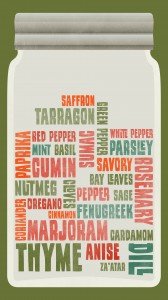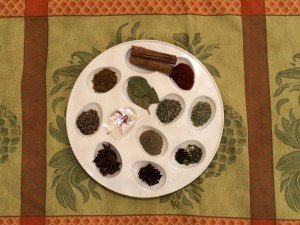Kids Activity Guide
 Cooking with herbs and spices can be a ton of fun, but sometimes it's difficult to introduce kids to new flavors. If you're working with a group that could benefit from a closer look at these taste boosters, check out this great activity guide, excerpted from the Communicating Food for Health newsletter.After all, it’s never too early to explore aromatic herbs and spices with kids.Food Science Lab 101 -- Making Sense of ScentsHere’s a fun scent experiment to do with children.Explore the sense of smell by setting out small bowls of herbs and spices on the table – use ones with rich aromas like cinnamon, basil, garlic, ginger, chocolate, cocoa, nutmeg, vanilla, etc.Allow your tot(s) to take a big sniff of each bowl and let them taste a tiny pinch of each one. Let them describe the scents and tastes of each one.Also, write out the names of each herb and spice for the child(ren) to see.Together, you can cook or bake a recipe using some of these aromatics -- it’s a fun way to transfer knowledge about the spice rack to the plate.By Victoria Shanta Retelny, RD, LDN, author of The Essential Guide to Healthy Healing Foods.To turn this activity from something you do at home to something you do in a classroom or at a presentation, follow these steps...Step One: Choose your herbs/spices and method of presentation.
Cooking with herbs and spices can be a ton of fun, but sometimes it's difficult to introduce kids to new flavors. If you're working with a group that could benefit from a closer look at these taste boosters, check out this great activity guide, excerpted from the Communicating Food for Health newsletter.After all, it’s never too early to explore aromatic herbs and spices with kids.Food Science Lab 101 -- Making Sense of ScentsHere’s a fun scent experiment to do with children.Explore the sense of smell by setting out small bowls of herbs and spices on the table – use ones with rich aromas like cinnamon, basil, garlic, ginger, chocolate, cocoa, nutmeg, vanilla, etc.Allow your tot(s) to take a big sniff of each bowl and let them taste a tiny pinch of each one. Let them describe the scents and tastes of each one.Also, write out the names of each herb and spice for the child(ren) to see.Together, you can cook or bake a recipe using some of these aromatics -- it’s a fun way to transfer knowledge about the spice rack to the plate.By Victoria Shanta Retelny, RD, LDN, author of The Essential Guide to Healthy Healing Foods.To turn this activity from something you do at home to something you do in a classroom or at a presentation, follow these steps...Step One: Choose your herbs/spices and method of presentation. Measure portions of your chosen aromatics into jars that travel well, or put them in ziplocs and move them over to bowls once you get to your site. Clear containers are best, if you can get them, because they add a visual component to the activity.Step Two: Label your containers clearly.Use an index card propped against each bowl or taped to the table in front of each bowl. You could also write the names on masking tape and place them directly on the container.Step Three: Choose a recipe.You probably can’t combine all the featured herbs and spices in a single recipe, so focus on a few that work well together and really enhance a dish. Depending on the complexity of the recipe --and simpler is better here -- you could have the children divide into groups and prepare the recipe together. This, of course, would work better with cinnamon apples than a cinnamon layer cake, so decide what you want to do based on the abilities of your group.Step Four: Discuss.What did the children notice about each scent? What did it remind them of? How might they want to use the herb or spice in their snacks and meals? Brainstorm ways to use these foods healthfully.Discuss making the recipe. What was hard? What was easy? Why?For more great practitioner resources, check out the Communicating Food for Health newsletter. It's chock-full of the latest ideas and tons of nutrition news.
Measure portions of your chosen aromatics into jars that travel well, or put them in ziplocs and move them over to bowls once you get to your site. Clear containers are best, if you can get them, because they add a visual component to the activity.Step Two: Label your containers clearly.Use an index card propped against each bowl or taped to the table in front of each bowl. You could also write the names on masking tape and place them directly on the container.Step Three: Choose a recipe.You probably can’t combine all the featured herbs and spices in a single recipe, so focus on a few that work well together and really enhance a dish. Depending on the complexity of the recipe --and simpler is better here -- you could have the children divide into groups and prepare the recipe together. This, of course, would work better with cinnamon apples than a cinnamon layer cake, so decide what you want to do based on the abilities of your group.Step Four: Discuss.What did the children notice about each scent? What did it remind them of? How might they want to use the herb or spice in their snacks and meals? Brainstorm ways to use these foods healthfully.Discuss making the recipe. What was hard? What was easy? Why?For more great practitioner resources, check out the Communicating Food for Health newsletter. It's chock-full of the latest ideas and tons of nutrition news.


